

Adamic. A social network caught in the Web by Lada A.
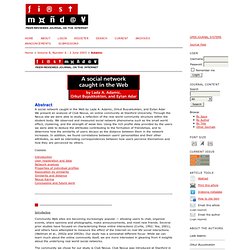
Adamic, Orkut Buyukkokten, and Eytan AdarWe present an analysis of Club Nexus, an online community at Stanford University. Through the Nexus site we were able to study a reflection of the real world community structure within the student body. We observed and measured social network phenomena such as the small world effect, clustering, and the strength of weak ties. Using the rich profile data provided by the users we were able to deduce the attributes contributing to the formation of friendships, and to determine how the similarity of users decays as the distance between them in the network increases.
In addition, we found correlations between users' personalities and their other attributes, as well as interesting correspondences between how users perceive themselves and how they are perceived by others. Figure 3: Distribution of user to user distances, with an average of 4 hops. Internet Business Models. The VPECT mind map. <<< back to - The 5D lens <<< Front page of article As I read the book and worked on this article, I used my usual tool for understanding new ideas and thinking through their implications: I built a mindmap.
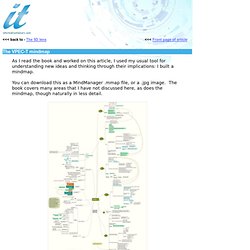
You can download this as a MindManager .mmap file, or a .jpg image. The book covers many areas that I have not discussed here, as does the mindmap, though naturally in less detail. Click the image to view a larger version. You can download the MindManager .mmap file itself from this link. Feel free to use the large image or mmap file in your own work, but please do not publish them except by the above thumbnail image, with a link to this page, or the front page of this article.
Videos - business model canvas videos and other startup frameworks. Chapter 2 Business Model Ontology Refinement and Visualization [HEC 4 ALL] Chapter 1 Introduction This chapter has two parts, the first part covers the refinement work which was done to BMO, and the second part takes an overview at available tools to represent visual models like the BMO. 2.1 Business Model Ontology Refinement Refinement of the model was done between the first and the second prototype but since the model is introduced here, it is a good opportunity to explain the choices applied to the model during the development of the application.
![Chapter 2 Business Model Ontology Refinement and Visualization [HEC 4 ALL]](http://cdn.pearltrees.com/s/pic/th/refinement-visualization-17757459)
Since BMO’s definition in the thesis of A.Osterwalder in 2004 , the BMO has been used and adapted in different versions (figure 2.1 (a.)). Product Vision. By Joel Spolsky Thursday, May 09, 2002 Editor's Note: As I constantly reiterate on these pages, good design requires making often difficult choices between imperfect options.

Making those decisions consistently requires a touchstone -- some kind of guiding principle -- often called a vision statement. For my company's product CityDesk, for example, a part of the vision was "content management when you can't run code on your web server. " That meant that features which required code on the server, like membership or discussion boards, were left out. Open innovation - Henry W. Chesbrough. Open Innovation offers a philosophy on organising innovation processes at corporate R&D departments.
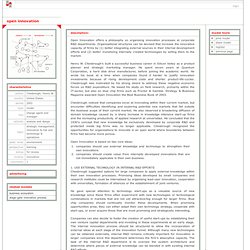
Organisational structures can be devised that increase the innovative capacity of firms by (1) better integrating external sources in their internal development efforts and (2) better monetizing internally created technologies by selling them to the market. Henry W. Chesbrough’s built a successful business career in Silicon Valley as a product planner and strategic marketing manager. He spent seven years at Quantum Corporation, a hard disk drive manufacturer, before joining the academic world. He wrote his book at a time when companies found it harder to justify innovation investments because of rising development costs and shorter product-life-cycles.
Blog / Customer Insight, Strategy, Design and Development. My IA Summit 2014 Talk on Stakeholder Mapping For the past couple of years I've been thinking about ways to better understand stakeholders for complex design projects so we can engage them more effectively.

Business Organizations & Human Resources Strategies: Corporate Governance, Change Management, And Corporate Learning. Mind Your Feedback Douglas Stone, coauthor of Thanks for the Feedback: The Science and Art of Receiving Feedback Well (Even When It Is Off-Base, Unfair, Poorly Delivered, and Frankly, You’re Not in the Mood), introduces a cautionary lesson in assessing others from Embodied Leadership: A Somatic Approach to Developing Your Leadership, by Pete Hamill.
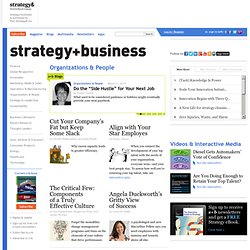
Are You Doing Enough to Retain Your Top Talent? To assess how well you’re retaining your top talent, take our interactive quiz. Rita Gunther McGrath on the End of Competitive Advantage The Columbia Business School professor says the era of sustainable competitive advantage is being replaced by an age of flexibility. Working Together Apart Scott Berkun’s chronicle of his stint as a team leader at WordPress.com offers insights for companies with distributed structures. Repository. Design activities Co-designing Envisioning Testing & Prototyping Implementing Representations.
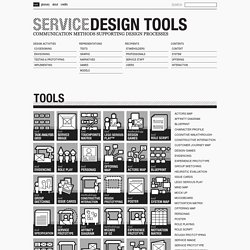
Visualization Methods. A Survey of Cognitive Engineering Methods and Uses. A Survey of Cognitive Engineering Methods and Uses Our survey provides an overview of the methods of Cognitive Engineering, as well as advice on how the methods of Cognitive Engineering can be applied to the challenges of designing complex systems. Our product is a set of matrices that show how Cognitive Engineering methods address Systems Engineering applications.
Click HERE for Phases Matrix.